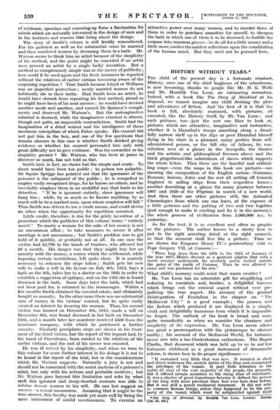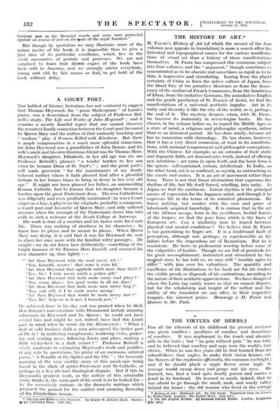HISTORY WITHOUT TEARS.* Tan child of the present day is
a fortunate creature. History, once one of the chief bugbears of the schoolroom,
is now becoming, thanks to people like Mr. H. G. Wells and Mr. Hendrik Van Loon, an entrancing recreation. Indeed, with a book like The Story of Mankind at his disposal, we cannot imagine any child desiring the plots and adventures of fiction. And the best of it is that the book is full, absolutely crammed, with pictures, all executed, like the History itself, by Mr. Van Loon ; and such pictures, too—just the sort one likes to look at, pictures which are attractive, imaginative and instructive, whether it is Hannibal's troops marching along a dread- fully narrow shelf up in the Alps or poor Hannibal himself dying in his chair in a pleasant, sunny portico from self- administered poison, or the hill city of Athens, its con- stitution seen at a glance in the Acropolis, the theatre and the artistic and philosophical freemen above and the thick gingerbread-like substratum of slaves which supports the whole below. Then there are the fanciful and enthral- ling maps—even the maps in this book are pictures—one showing the composition of the English nation. Normans, Romans, Saxons, Jutes and the rest all setting off towards England in sailing ships from their respective homes ; another describing at a glance the many journeys between 1607 and 1620 of the Pilgrims in search of a new world. And then there are other pictures still, the Animated Chronologies from which one can learn, at the expense of a little patience and the putting of two and two together (just enough to make it exciting and fix it in the memory), the whole process of civilization from 5,000,000 B.c. to yesterday.
As for the text, it is as excellent and often as graphic as the pictures. The author knows to a nicety how to put in the right arresting detail at the right moment, so that the moment shall live like a picture. Thus we are shown the Emperor Henry IV.'s penitentiary visit to Pope Gregory VII. at Canossa :-
" Three tong days, from the 25th to the 28th of January of the year 1077, Henry, dressed as a penitent pilgrim (but with a warm sweater underneath his monkish garb), waited outside the gates of the castle of Canossa. Then he was allowed to enter and was pardoned for his sins."
What child's memory could resist that warm sweater ?
Mr. Van Loon has an admirable gift for simplifying, and reducing to essentials and, besides, a delightful. humour which brings out the comical aspect without ever pre-
judicing the true aspect. His account of the gradual disintegration of Feudalism in the chapter on " The Mediaeval City " is a good example ; the process and the factors which produced it are displayed in a simple, vivid and delightfully humorous form which it is impossible to forget. The outlook of the book is broad and sane, quite remarkably so when we consider the clearness and simplicity of its expression. Mr. Van Loon never allows too great a preoccupation with the picturesque to obscure reality ; his account of the Mediaeval World, for instance, never errs into a too Chestertonian enthusiasm. The Magna Charta, that document which was held up to us in our less fortunate childhood as a great instrument of democratic reform, is shown here in its proper significance :—
" It contained very little that was new. It restated in short and direct sentences the ancient duties of the king and enumerated the privileges of his vassals. It paid little attention to the rights (if any) of the vast majority of the people, the peasants. but it offered certain securities to the rising elnss of merchants. It was a charter of great importance because it defined the powers of the king with more precision than had ever been done before. But it was still a purely mediaeval document. It did not refer to common human beings, unless they happened to be the pro- perty of the vassal, which must be safeguarded against royal *The Story of Af.nkind. By Hendrik Tan Loon. London: Ilauldh (12s. 6d. net.] tyranny just as the Baronial woods and cows were protected against an excess of zeal on the Tart of the royal foresters."
But though by quotation we may illustrate some of the minor merits of the book, it is impossible thus to give a just idea of its particular excellence, which lies in the vivid summaries of periods and processes. We are not surprised to learn that 50,000 copies of the book have been sold in America, and we strongly advise everybody, young and old, by fair means or foul, to get hold of the book without delay.



































































 Previous page
Previous page